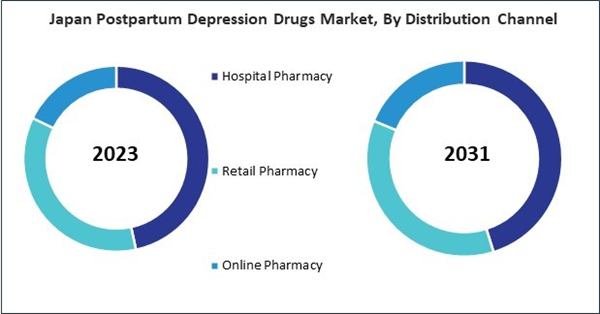The China market dominated the Asia Pacific Postpartum Depression Drugs Market by Country in 2023, and would continue to be a dominant market till 2031; thereby, achieving a market value of $123.9 million by 2031. The Japan market is registering a CAGR of 9.3% during (2024 - 2031). Additionally, The India market would showcase a CAGR of 10.6% during (2024 - 2031).
Postpartum depression medications are frequently combined with other therapeutic approaches to ensure comprehensive care. This includes psychotherapy (such as cognitive-behavioral therapy), support groups, and lifestyle modifications. The combination of pharmacotherapy and psychotherapy has been shown to improve treatment outcomes, reduce symptom severity, and enhance overall well-being for women experiencing postpartum depression.
The adoption of postpartum depression drugs refers to the utilization and acceptance of pharmacological treatments among healthcare providers and patients for managing symptoms of postpartum depression (PPD). Adoption rates can vary significantly based on healthcare access, cultural attitudes toward mental health, and healthcare provider practices. Adoption begins with healthcare providers’ awareness and knowledge of postpartum depression as a significant mental health issue. Providers trained in perinatal mental health are more likely to recognize symptoms of PPD and initiate appropriate treatments, including pharmacotherapy.
As China's middle class expands and healthcare access improves, there is a growing demand for specialized healthcare services, including mental health treatments. This demographic shift fuels the market for PPD drugs, prompting pharmaceutical companies to invest in meeting this increasing demand. Chinese pharmaceutical firms often collaborate with international partners to leverage global expertise and technologies in developing PPD drugs. These collaborations facilitate the transfer of knowledge and accelerate the introduction of innovative therapies into the Chinese market. Thus, the increasing pharmaceutical industry is driving the growth of the market.
Based on Treatment, the market is segmented into Pharmacotherapy, Hormonal Therapy, and Others. Based on Route of Administration, the market is segmented into Oral, Parenteral, and Others. Based on Distribution Channel, the market is segmented into Hospital Pharmacy, Retail Pharmacy, and Online Pharmacy. Based on Type, the market is segmented into Postpartum Anxiety, Postpartum Blues, Postpartum Obsessive-Compulsive Disorder (OCD), Postpartum Panic Disorder, Postpartum Post-Traumatic Stress Disorder (PTSD), and Postpartum Psychosis. Based on countries, the market is segmented into China, Japan, India, South Korea, Singapore, Malaysia, and Rest of Asia Pacific.
List of Key Companies Profiled
- Pfizer, Inc.
- Eli Lilly And Company
- Novartis AG
- GlaxoSmithKline PLC (GSK)
- Merck & Co., Inc.
- Biogen, Inc.
- Teva Pharmaceutical Industries Ltd.
- Bausch Health Companies, Inc.(DermTech, Inc.)
- Cipla Limited
- Sage Therapeutics, Inc.
Market Report Segmentation
By Treatment- Pharmacotherapy
- Hormonal Therapy
- Others
- Oral
- Parenteral
- Others
- Hospital Pharmacy
- Retail Pharmacy
- Online Pharmacy
- Postpartum Anxiety
- Postpartum Blues
- Postpartum Obsessive-Compulsive Disorder (OCD)
- Postpartum Panic Disorder
- Postpartum Post-Traumatic Stress Disorder (PTSD)
- Postpartum Psychosis
- China
- Japan
- India
- South Korea
- Singapore
- Malaysia
- Rest of Asia Pacific
Table of Contents
Companies Mentioned
- Pfizer, Inc.
- Eli Lilly And Company
- Novartis AG
- GlaxoSmithKline PLC (GSK)
- Merck & Co., Inc.
- Biogen, Inc.
- Teva Pharmaceutical Industries Ltd.
- Bausch Health Companies, Inc.(DermTech, Inc.)
- Cipla Limited
- Sage Therapeutics, Inc.
Methodology

LOADING...









